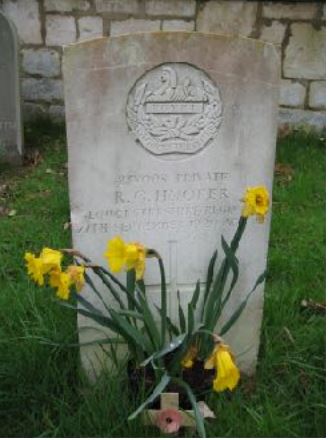2/4th Battalion, Gloucestershire Regiment

Renford Charles Hooper was the son of William and Harriet Hooper. William was an agricultural worker. There is some confusion as to Renford’s date of birth. According to the CWGC register he was aged 42 when he died in 1920, which would give his birth year as 1878. However, on his Army attestation papers he stated his age (in 1915) to be 35 years and five months, which would mean it was 1880. In the 1881 Census return he is shown as being eight months, which again points to 1880 as his birth year and there does appear to be an entry in the Register of Births, which could well be his, for the second quarter of 1880. This date seems the most likely and the CWGC Register is inaccurate.
It would appear that Renford’s mother died in 1883 – she is missing from the 1891 Census onwards.
At Christmas 1904 Renford married Ellen Moss (born October 1876) and they had two children, born in February 1906 and September 1910. They lived at Bond End, Upton-St-Leonards.
Renford attested for military service on 8 December 1915, giving his occupation as a cowman. He stated that he had six years previous military service with the ‘Garrison Artillery’, but there are no further details of this. He was immediately placed into the Reserve and was finally mobilized on 20 June 1916, being posted to the 2/4th (Territorial) Battalion, Gloucestershire Regiment the following day. He was allocated the number 6121. In 1917 the Territorial Force undertook a renumbering exercise, which resulted in Renford being given the new number of 238008.
Renford saw service abroad but was discharged on 13 September 1917 as no longer physically fit for war service and on 28 October 1917 he was allocated a Silver War Badge. The reason for the discharge is not specified in the papers which survive from his Army Service Record at the National Archives but his Silver War Badge record states it was due to sickness. His Pension Record Card, released to the public in late 2018, via the Ancestry website, states his disability to be ‘VHD (aortic)’, which no doubt stands for Valvular Heart Disease, attributable to his military service. He was granted an Army pension of 18 shillings (90p) per week form 12 May 1920, this reflecting a 40% disability assessment. He died at Gloucester on 27 September 1920, aged 42, and was buried in the local parish churchyard, his grave marked with a standard CWGC headstone
Researched by Graham Adams 13 January 2019 (revised)
